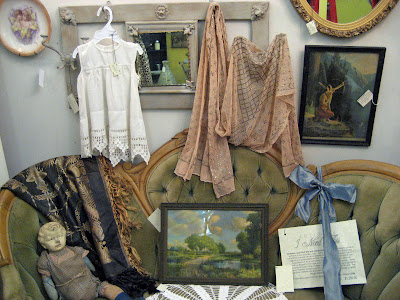Okay, okay, I know it is supposed to be white Wednesday but I was feeling the rebel and decided to go to the dark side (they always have cookies anyway) and offer up a black lace Wednesday in its place. I adore textiles and especially lace. The idea that anyone would spend hours twisting bobbins to create an inch of lace fascinates me and one of the most lovely of the bobbin made laces is “Chantilly Lace.” Pronounced “shawn tew lee”, this bobbin made lace originated in Chantilly, north of Paris…only the French could conceive of such beauty utilizing fine silk threads.
The earliest chantilly lace was known as “Blonde lace” and the name comes from the natural golden blonde color of the silk used to create the bobbin lace.
Blonde lace lost interest with women of the court but the use of black silk revitalized interest in this magnificent bobbin lace technique.
Closeup of the detail of this handmade laces twists and turns. Incredible.
Bobbin lace strip with hundreds of pins holding silk in place.
Lace making pillow, pins and bobbins.
The size of the pillow used determines the size of the lace strip. Large pieces required lots of work space.
Museum piece - Lovely lace bedspread from the 18th century.
Detail of the cupids on the bedspread. How many hundreds of hours did this lovely spread take?
The production of Chantilly lace flourished under Louis XV (1715-1774) and was a special favorite of his last mistress and of course, the lovely Marie Antoinette.
When the French Revolution began, demand for the lace ceased as the lace makers were seen as followers of the royals and following the guillotining of Marie Antoinette, the lace makers of Chantilly were killed, of which all production had ceased.
Napoleon sponsored revivals of Chantilly lace, most especially between the years 1804 and 1815 and at this point production was concentrated in Normandy, mainly around the Bayeux area. While it was no longer being made in Chantilly, all of the old techniques and designs were used. Chantilly lace reached the height of its popularity around 1830 and was revived again in the 1860s.
I love the detail and realism of the florals and designs in chantilly lace. Truly gossamer in its look and touch. These lovely huge shawls are light as a feather.
In 1844 a machine was patented that made black silk Chantilly lace that was difficult to distinguish from the handmade lace. Good machine made imitation were now available. Both they and the more expensive handmade kind were fashionable from the mid-century on, when shawls and even whole mantles of Chantilly were worn over a crinoline.
A favorite piece among the Civil War widows...an elegant sign of mourning.
Detail of shawl, Circa 1865.
Modern machine made chantilly lace Circa 1900s. Just as lovely as the antique, hand made pieces.
Beautiful chantilly lace dress from the 1890s
Machine lace from the 1950s.
Lovely chantilly lace dress from the 1940s. Sophistication at its best.
Lace has such universal appeal and there are so many types available. Bobbin or machined, crocheted or knitted, twisted or knotted, the next time you come across vintage pieces at a yard sale, an antique store or a museum, look a little closer at how it was created. You will have a new appreciation for this lovely textile. Sea Witch























































.jpg)











